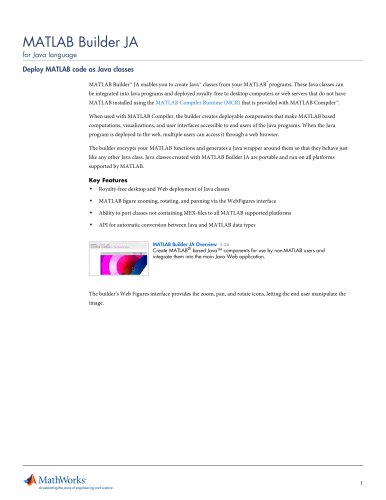
Catalog excerpts
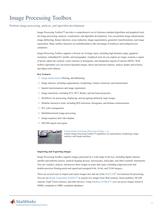
Image Processing Toolbox Perform image processing, analysis, and algorithm development Image Processing Toolbox™ provides a comprehensive set of reference-standard algorithms and graphical tools for image processing, analysis, visualization, and algorithm development. You can perform image enhancement, image deblurring, feature detection, noise reduction, image segmentation, geometric transformations, and image registration. Many toolbox functions are multithreaded to take advantage of multicore and multiprocessor computers. Image Processing Toolbox supports a diverse set of image types, including high dynamic range, gigapixel resolution, embedded ICC profile, and tomographic. Graphical tools let you explore an image, examine a region of pixels, adjust the contrast, create contours or histograms, and manipulate regions of interest (ROIs). With toolbox algorithms you can restore degraded images, detect and measure features, analyze shapes and textures, and adjust color balance. Key Features ▪ Image enhancement, filtering, and deblurring ▪ Image analysis, including segmentation, morphology, feature extraction, and measurement ▪ Spatial transformations and image registration ▪ Image transforms, including FFT, DCT, Radon, and fan-beam projection ▪ Workflows for processing, displaying, and navigating arbitrarily large images ▪ Modular interactive tools, including ROI selections, histograms, and distance measurements ▪ ICC color management ▪ Multidimensional image processing ▪ Image-sequence and video display ▪ DICOM import and export Getting Started with Image Processing Toolbox 4:44 Explore Image Processing Toolbox™ capabilities for segmentation, morphology, image statistics, and Hough transform. Importing and Exporting Images Image Processing Toolbox supports images generated by a wide range of devices, including digital cameras, satellite and airborne sensors, medical imaging devices, microscopes, telescopes, and other scientific instruments. You can visualize, analyze, and process these images in many data types, including single-precision and double-precision floating-point and signed and unsigned 8-bit, 16-bit, and 32-bit integers. There are several ways to import and export images into and out of the MATLAB® environment for processing. You can use Image Acquisition Toolbox™ to acquire live images from Web cameras, frame grabbers, DCAM cameras, GigE Vision cameras, and other devices. Using Database Toolbox™, you can access images stored in ODBC-compliant or JDBC-compliant databases.
Open the catalog to page 1
Standard and Specialized Formats Supported MATLAB supports standard data and image formats, including JPEG, JPEG-2000, TIFF, PNG, HDF, HDF-EOS, FITS, Microsoft® Excel®, ASCII, and binary files. It also supports the multiband image formats BIP and BIL, as used by LANDSAT. Low-level I/O and memory mapping functions enable you to develop custom routines for working with any data format. Image Processing Toolbox supports a number of specialized image file formats. For medical images, it supports DICOM files, including associated metadata, as well as the Analyze 7.5 and Interfile formats. The...
Open the catalog to page 2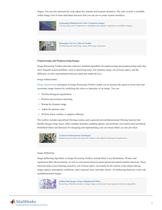
shapes. You can also interactively crop, adjust the contrast, and measure distances. The suite of tools is available within Image Tool or from individual functions that you can use to create custom interfaces. Enhancing Multispectral Color Composite Images Constructing color composites to highlight and segment vegetation in satellite imagery. Detecting Cars in a Video of Traffic Visualizing and analyzing videos and image sequences. Preprocessing and Postprocessing Images Image Processing Toolbox provides reference-standard algorithms for preprocessing and postprocessing tasks that solve...
Open the catalog to page 3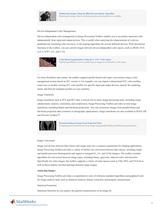
Deblurring Images Using the Blind Deconvolution Algorithm Restoring an image when no information about the distortion is available. Device-Independent Color Management Device-independent color management in Image Processing Toolbox enables you to accurately represent color independently from input and output devices. This is useful when analyzing the characteristics of a device, quantitatively measuring color accuracy, or developing algorithms for several different devices. With specialized functions in the toolbox, you can convert images between device-independent color spaces, such as...
Open the catalog to page 4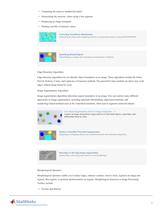
▪ Computing the mean or standard deviation ▪ Determining the intensity values along a line segment ▪ Displaying an image histogram ▪ Plotting a profile of intensity values Correcting Nonuniform Illumination Enhancing an image and computing statistics of segmented objects using REGIONPROPS. Identifying Round Objects Thresholding an image and calculating measurements of objects. Edge-Detection Algorithms Edge-detection algorithms let you identify object boundaries in an image. These algorithms include the Sobel, Prewitt, Roberts, Canny, and Laplacian of Gaussian methods. The powerful Canny...
Open the catalog to page 5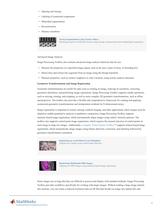
▪ Opening and closing ▪ Labeling of connected components ▪ Watershed segmentation ▪ Reconstruction ▪ Distance transform Texture Segmentation Using Texture Filters Identifying regions of different textures using entropy measurements and morphological operations. Advanced Image Analysis Image Processing Toolbox also contains advanced image analysis functions that let you: ▪ Measure the properties of a specified image region, such as the area, center of mass, or bounding box ▪ Detect lines and extract line segments from an image using the Hough transform ▪ Measure properties, such as surface...
Open the catalog to page 6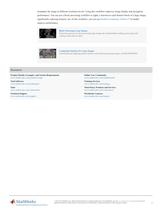
resamples the image at different resolution levels. Using this workflow improves image display and navigation performance. You can use a block processing workflow to apply a function to each distinct block of a large image, significantly reducing memory use. In this workflow, you can use Parallel Computing Toolbox™ to further improve performance. Block Processing Large Images Reducing memory use for processing large images by incrementally reading, processing, and writing results back to disk. Computing Statistics for Large Images Calculating and applying global statistics when processing...
Open the catalog to page 7All The MathWorks catalogs and technical brochures
-
MATLAB Production Server
6 Pages
-
Database Toolbox
4 Pages
-
MATLAB Report Generator
4 Pages
-
Stateflow
8 Pages
-
SimEvents
7 Pages
-
SimDriveline
7 Pages
-
SimHydraulics
7 Pages
-
SimPowerSystems
8 Pages
-
Simulink Control Design
5 Pages
-
Aerospace Blockset
5 Pages
-
SimRF
6 Pages
-
Simulink Coder
6 Pages
-
Embedded Coder
8 Pages
-
Simulink PLC Coder
4 Pages
-
Fixed-Point Designer
9 Pages
-
MATLAB Coder
5 Pages
-
Simulink 3D Animation
10 Pages
-
Gauges Blockset
2 Pages
-
Simulink Report Generator
3 Pages
-
Polyspace Bug Finder
6 Pages
-
global-optimization-toolbox
10 Pages
-
Phased Array System Toolbox
9 Pages
-
OPC Toolbox
5 Pages
-
Simulink Design Verifier
7 Pages
-
Simulink Design Optimization
10 Pages
-
Filter Design HDL Coder
5 Pages
-
Bioinformatics Toolbox
9 Pages
-
SimBiology
6 Pages
-
Computer Vision System Toolbox
10 Pages
-
DSP System Toolbox
11 Pages
-
Fuzzy Logic Toolbox
5 Pages
-
Polyspace Client for C/C++
5 Pages
-
xPC Target
5 Pages
-
SimMechanics
7 Pages
-
Simscape
7 Pages
-
Simulink
6 Pages
-
Data Acquisition Toolbox
8 Pages
-
Signal Processing Toolbox
10 Pages
-
Control System Toolbox
6 Pages
-
Symbolic Math Toolbox?
6 Pages
-
Parallel Computing Toolbox?
7 Pages
-
MATLAB®
6 Pages
-
Mapping Toolbox 3.2
7 Pages
-
Instrument Control Toolbox
7 Pages
-
Optimization Toolbox 6.0
14 Pages
Archived catalogs
-
MATLAB Release Notes
505 Pages
-
C and Fortran API Reference
263 Pages
-
External Interfaces
649 Pages
-
Function Reference: Volume 3 (P-Z)
1696 Pages
-
Function Reference: Volume 2 (F-O)
1568 Pages
-
Function Reference: Volume 1 (A-E)
1298 Pages
-
Creating Graphical User Interfaces
520 Pages
-
3-D Visualization
212 Pages
-
Graphics
667 Pages
-
MATLAB Programming Tips
66 Pages
-
Programming Fundamentals
840 Pages
-
Data Analysis
220 Pages
-
Mathematics
316 Pages
-
MATLAB® Getting Started Guide
250 Pages



